Introduction: The Science Behind Email Timing
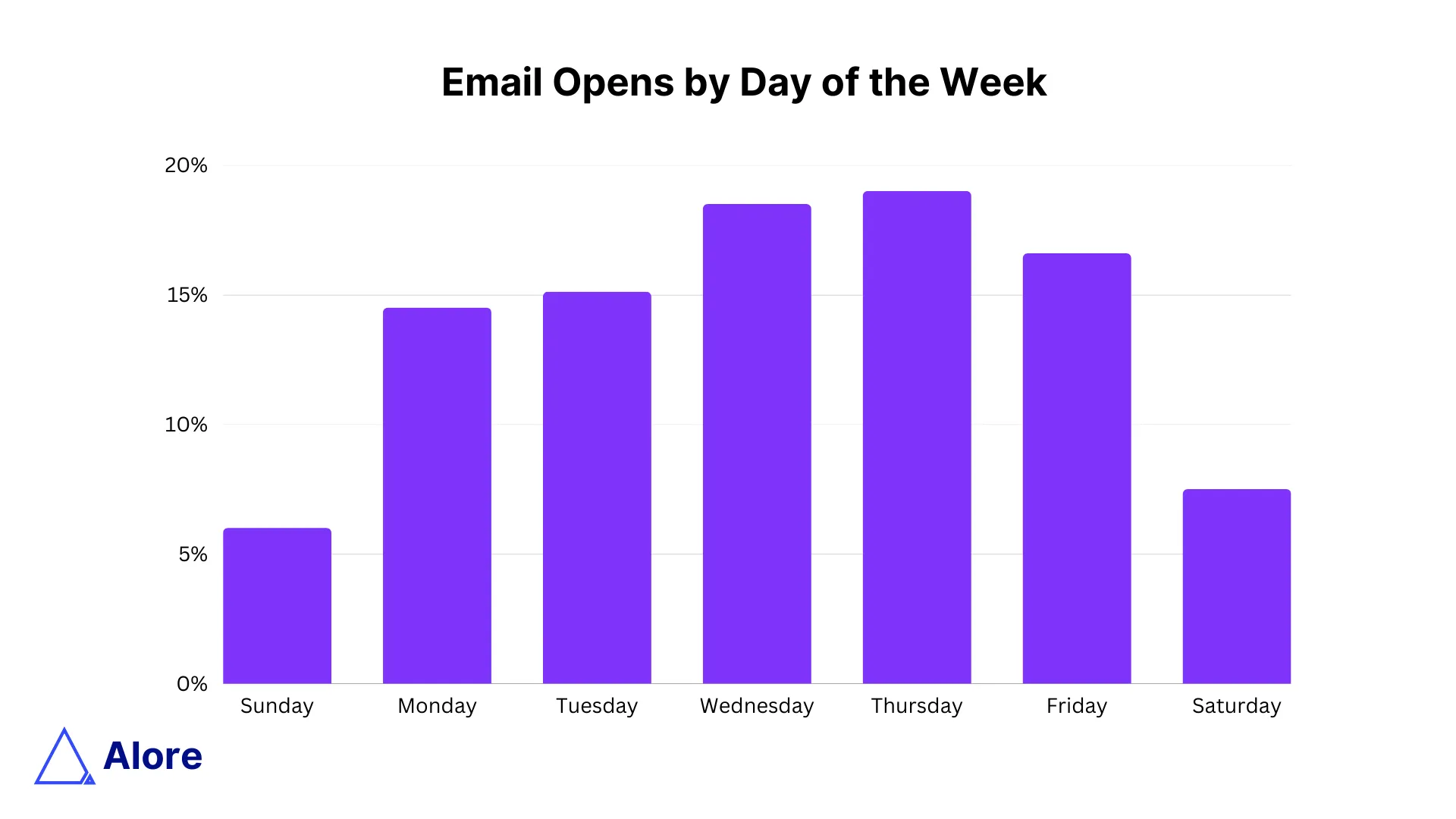
Welcome to the thrilling world of email timing, a universe where each tick of the clock carries the weight of potential clicks, conversions, and customer connections.
Yes, folks, we're about to explore the tantalizing terrain of timestamps!
1.1 The Fascinating Interplay of Timing and Engagement: Why it Matters
Ever wonder why some of your marketing emails generate lots of buzz while others seem to fall into the abyss?
The secret sauce might not be the content but the timing.
Think about your own behavior - are you more likely to engage with a newsletter that arrives during your busy work hours or one that hits your inbox when you're sipping your morning coffee?
Timing, as they say, is everything. When we get the timing right, it's like hitting a sweet spot that can dramatically boost engagement, improve click-through rates, and drive conversions.
1.2 Unleashing the Power of Timing: Setting the Stage for Success
Now, this isn't some hocus-pocus magic trick.
It's a strategic move backed by rigorous testing, data analysis, and understanding your target audience's behavior.
Getting the timing right can dramatically improve your email marketing campaign's performance.
It's like shooting an arrow – you need to find the perfect angle, the perfect tension, and of course, the perfect timing.
And what happens when you get all these aspects right? Bullseye!
1.3 The Email Marketing Landscape in 2023: What's New and What's Next
Email marketing has been around for quite some time, but it's far from becoming obsolete. In fact, in 2023, it's more powerful than ever, with new innovations and data-driven strategies giving it a fresh breath of life. Among these is the growing understanding of the importance of email timing. Now, we're not just blindly sending out email blasts but focusing on the best time to send marketing emails.
1.4 The Rise of Data-Driven Marketing: Why Email Timing Isn't Guesswork Anymore
Once upon a time, email marketers often would rely on intuition or best guesses to determine their email timings. However, in today's world, we've moved beyond guesswork to a more sophisticated approach: data-driven marketing. With this, we can analyze subscriber behaviors, engagement patterns, and optimal response times to pinpoint the best time to send marketing emails. Suddenly, sending out emails isn't about casting a wide net; it's more akin to an archer aiming for the bullseye.
1.5 Making Sense of the Numbers: Navigating Email Metrics and Benchmarks
As we dive into the science of email timing, you'll come across terms like click-through, open, and bounce rates. Don't be alarmed! We'll help you navigate these waters and explain in layman's terms what they mean and why they matter. After all, understanding your email metrics is crucial to gauging the effectiveness of your email marketing strategy and refining it for better results.
1.6 A Sneak Peek Into the Guide: What You Can Expect to Learn
As we embark on this journey together, we'll explore the intriguing world of email timing, how it impacts your email marketing, and the proven strategies to determine the best time to send marketing emails. Ready to take your email marketing to the next level? You're in the right place! Now, buckle up and let's dive right into the fascinating science behind email timing. This isn't just another guide; it's your roadmap to mastering the art of email timing. And who knows? By the end, you may very well become the next email marketing maestro!
The Best Times to Send Marketing Emails in 2023: A Comprehensive Overview
General Email Send Time Advice
Have you ever wondered, "What's the ideal time to send my marketing emails?"
You're certainly not alone. Marketers everywhere are in the constant pursuit of that elusive 'sweet spot' to boost their email open rates and conversions.
As a seasoned marketer, you're probably familiar with the generally accepted wisdom around the best times to send marketing emails. The consensus seems to have settled on Tuesday through Thursday, between 10 am and 2 pm. But hold on! Is that really all there is to it?
Remember, these recommendations aren't set in stone.
They're the result of countless studies and analyses over the years.
However, they provide a good starting point. You can use these recommendations as a baseline and then adapt and optimize based on your own data and insights.
The golden rule in email marketing, just as in any other field, is that every audience is different.
Thus, the most effective email send time is highly dependent on your specific audience's behavior and preferences. So, don't just rely on universal best practices.
Instead, try testing different send times to see what works best for your audience.
But here's the unexpected twist...
Ignoring Commonly Accepted Advice: The Unexpected Truth
In the marketing world, sometimes the tried-and-true isn't necessarily the be-all and end-all. Have you ever considered ignoring the commonly accepted advice and forging your own path? If not, buckle up because we're about to dive into the unexpected truth behind email send times.
Let's take a trip down memory lane to 2009. One email marketer decided to challenge the status quo and began sending marketing emails at 2 am. The results were staggering! While this goes against the typical 'business hours' advice, their open rates and click-through rates soared. How can that be?
Well, think about it. At 2 am, there's less competition in the inbox.
People might check their emails first thing in the morning, and there's your email sitting on top, without being buried under the sea of daytime emails.
This means that your email stands a better chance of getting noticed and opened.
Now, we're not saying you should all start sending your emails at 2 am.
This example just shows that sometimes, bending the rules can work in your favor. Your best send time might fall outside the so-called 'prime times' during the regular working hours each week.
In essence, when it comes to finding the best time to send marketing emails, there are two critical elements you should bear in mind: competition and recipient activity. To maximize your next email campaign's visibility, you should aim to send your emails when your competition is low but your recipients' activity is high.
So, how do you figure out the best time to send your marketing emails in 2023? Here's a step-by-step guide to help you out:
- Start with the general advice: Use the widely accepted best send times as a starting point.
- Know your audience: Understand the daily routine of your recipients. What time do they typically check their emails? Are they early birds or night owls?
- Test different send times: Don't shy away from experimenting with different send times. Analyze the results to understand which time slots work best for your audience.
- Use email marketing software: Leverage the power of email marketing software to gather data and gain insights into your audience's behavior and preferences.
- Optimize your send times: Based on your test results and data, optimize your send times to maximize open rates and conversions.
Remember, email marketing isn't an exact science. The "best time" might vary from one audience to another, from one industry to another, and even from one geographical location to another. Hence, it's crucial to take a data-driven approach and continuously test and tweak your strategies.
I'm sure you're wondering, "What does the data say about the best days and times to send emails in 2023?" We'll be exploring this in the next section, so stick around!
TL;DR
Finding the best time to send marketing emails in 2023 might require you to shake up the generally accepted wisdom. The key is to understand your audience, test different send times, analyze the results, and optimize your strategies accordingly. So, are you ready to break the mold and uncover the 'sweet spot' for your email marketing campaigns? Let's dive in!
Understanding Your Audience: The Role of Demographics
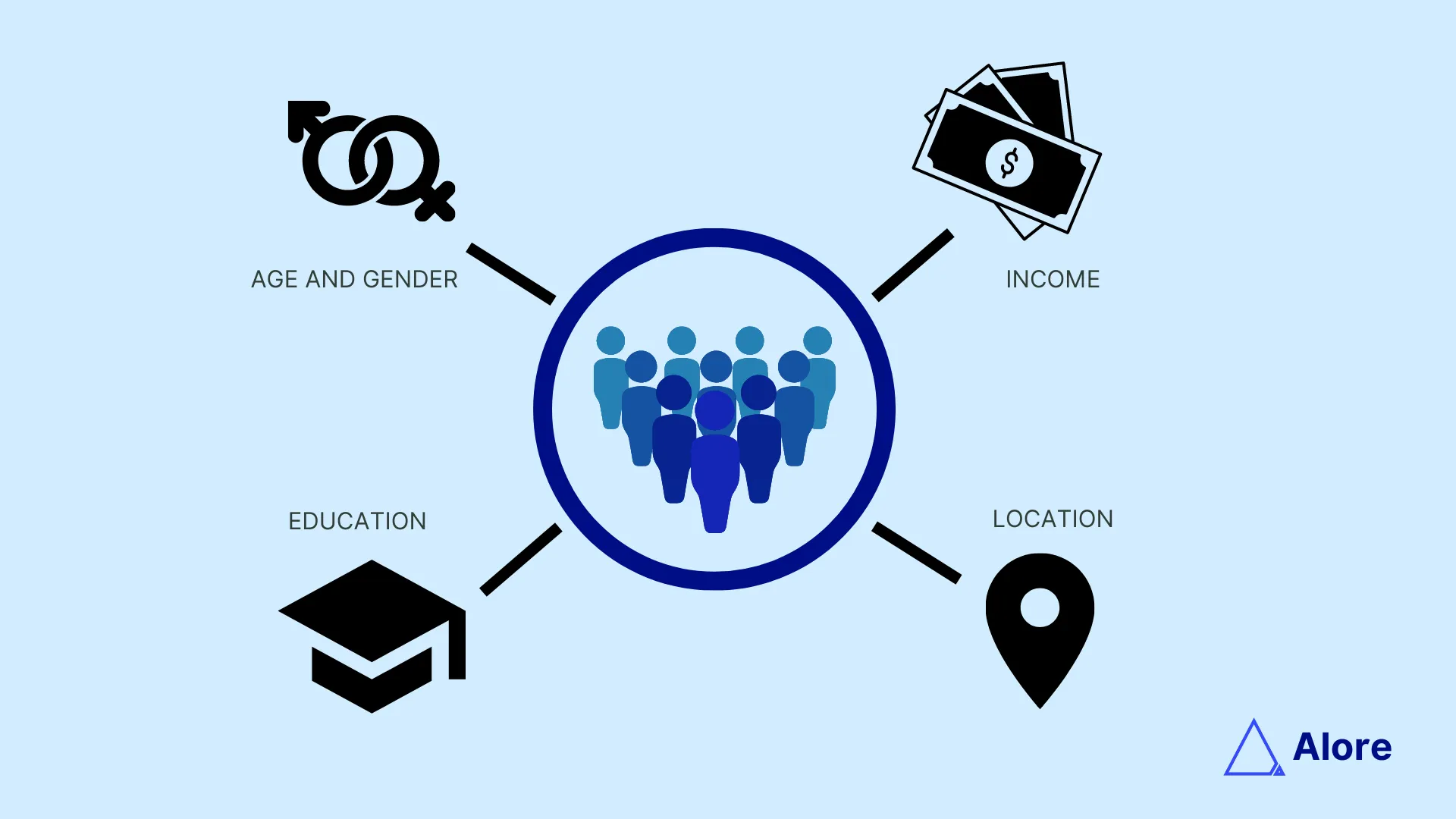
It's time to dive deeper into the world of email engagement and your audience demographics. After all, knowing your audience is the key to nailing the best time to send marketing emails, wouldn't you agree?
Age and Gender Considerations
Ever tried chatting about the latest TikTok trends with a baby boomer? Or discussing pension plans with a Gen Z? It feels off, right? Similarly, sending marketing emails without considering the age and gender of your recipients can lead to mismatched communication.
Let's illustrate with a hypothetical scenario. Let's say your audience consists mostly of young millennials who work freelance jobs. They're not your typical nine-to-five crowd, so sending emails during the day might not get you the best open rates. Late evening or night might be more optimal because that's when they're wrapping up their day's work.
And what about gender considerations? Well, studies suggest that women are more likely to check their emails more frequently than men. If your brand primarily targets women, factoring this into your email send time strategy is essential.
Remember, there's no one-size-fits-all here. The point is to understand who you're communicating with and tailor your strategies accordingly.
Device Usage Habits

Now, think about your device usage habits. Do you check emails on your phone first thing in the morning? Or do you prefer using a desktop during the day? Your audience likely has similar preferences too.
With the increase in the mobile devices usage, many people check their emails on their phones first thing in the morning or during commutes. If this holds true for your audience, early morning could be the best time to send your marketing emails. On the other hand, if your audience primarily consists of office-goers who prefer checking emails on desktops, sending marketing emails occurred during office hours might be more beneficial.
The bottom line? Understanding your audience's mobile device usage habits can significantly impact your email open rates.
Time Zone Differences
And let's not forget the time zone factor! You might need to juggle multiple time zones if you're targeting a global audience. Imagine the frustration of receiving an email at 3 am just because the sender didn't consider your time zone. Not a pleasant customer experience, is it?
Take time zones into account when scheduling your emails and send email campaigns. Some email marketing tools even allow you to automate this process, so your emails arrive at the 'right' time in each recipient's time zone. Isn't that convenient?
In conclusion, understanding your audience demographics plays a significant role in deciding the best time to send marketing emails. By taking into account age and gender, device usage habits, and time zone differences, you can fine-tune your email marketing strategy for higher open rates and conversions.
Remember, these factors are interconnected. An effective email strategy considers all these elements together, not in isolation. So why wait? Start analyzing your audience demographics today and take your email marketing game to the next level!
Understanding your audience demographics - age and gender, device usage habits, and time zone differences - is crucial in determining the best time to send marketing emails to email subscribers. It allows you to tailor your communication to your audience's preferences, enhancing engagement and boosting your open rates. The key takeaway here? Know your audience, and success will follow.
Crucial Statistics: Insights From Multiple Studies

Welcome to the numbers game!
We're talking about statistics, the backbone of any data-driven approach.
This section will delve into key studies about the best time to send marketing emails. So, put your analytical hat on, and let's explore together.
Get Response, HubSpot, and Intercom Statistics

Three industry giants, GetResponse, HubSpot, and Intercom, have extensively studied email marketing trends. These research efforts, my friend, are a goldmine of information for anyone willing to strike email marketing gold. So, what do these studies tell us?
GetResponse, for instance, found that Tuesday had the next highest open rate and click rates, followed by Thursday. So, if you're gunning for higher open rates, Tuesday might be your lucky charm.
Meanwhile, HubSpot's data suggested that the optimal send time is 11 AM ET. So, if you were to send an email blast, 11 AM ET might be a good bet.
Intercom, on the other hand, suggests that the best day to send emails is Thursday. You'd probably agree if you're a fan of Thursday night sitcoms!
But wait, you might be wondering, "Why are these studies suggesting different days and times?" That's a great question! Remember, these studies analyze large datasets that encompass various industries and demographics. Consequently, the "best" time may vary. The key is to understand your specific audience and industry trends.
Visual Data from Various Studies

For all you visual learners out there, buckle up because we're about to paint a statistical picture of the best and worst time to send marketing emails.
From this visual data, it's clear that weekdays have higher open rates than weekends. The reason? Most people use their weekends to disconnect from work-related communications. On weekdays, the time slots between 10 AM and 12 PM consistently show higher open rates. Why so? This is typically when people have settled into their workday and take a break to check their emails.

Remember, visuals aren't just about making your content look good. They are tools to simplify complex data and draw attention to key points. So, keep these visual aids handy for your next email marketing strategy meeting.
By looking at these statistics and visuals, it's clear that finding the best time to send marketing emails is a blend of science and art. It's about combining empirical data with an understanding of your specific audience habits.
The best time to send marketing emails? Well, it depends. Studies from GetResponse, HubSpot, and Intercom present different optimal times, showcasing the importance of understanding your audience. Visual data further illustrates these differences, underscoring that the best time is usually during the weekdays and peak open rates occur between 10 AM and 12 PM. The takeaway? Use these insights as a starting point, but never stop fine-tuning your approach based on your audience's response.
Breaking Down Best Email Send Times by Days of The Week

Best Days to Send Emails

Let's start with the good news.
Yes, there are indeed 'golden days' for email sending and marketing emails; no, they are not all created equal.
Imagine, for a moment, that you're in a game show. The question of the day is, "Which days are best to send emails for optimum click to open rate and rates?" Would you bet on weekdays or weekends?
If your answer was on weekdays, congratulations!
You've won the round.
According to a report from Campaign Monitor, Tuesday, Wednesday, and Thursday have the highest email open rates.
My dear reader, these three musketeers of the week are your safest bets.
Why, you ask? Well, think about it. By Tuesday, people have already recovered from their 'Monday blues,' and they're fully in work mode, dealing with their inboxes. Wednesday and Thursday continue this trend with people at the peak time of their productivity.
So, if you're thinking about the best day to send marketing emails, set your sights on these three amigos. But remember, this is a general rule, and variations can occur depending on your specific audience.
Worst Days to Send Emails
Now, onto the not-so-rosy part.
The same report suggests that the open rates take a nosedive on weekends. Saturday and Sunday, it seems, are not so popular among the email gods.
Picture this, it's a sunny Saturday afternoon, and you're enjoying a lazy brunch or a family outing. How likely are you to pay attention to marketing emails?
Not so much, right?
Similarly, for most folks, Sunday is about mentally preparing for the week ahead.
Chances are, they're not too keen on checking marketing messages. Hence, weekends might be best reserved for rest, relaxation, and maybe some email marketing planning for the weekdays!
So, as a rule of thumb, it might be best to avoid scheduling your main email marketing blasts on the weekends.
But, again, there can always be exceptions based on your audience's unique habits.
Quick Snapshot
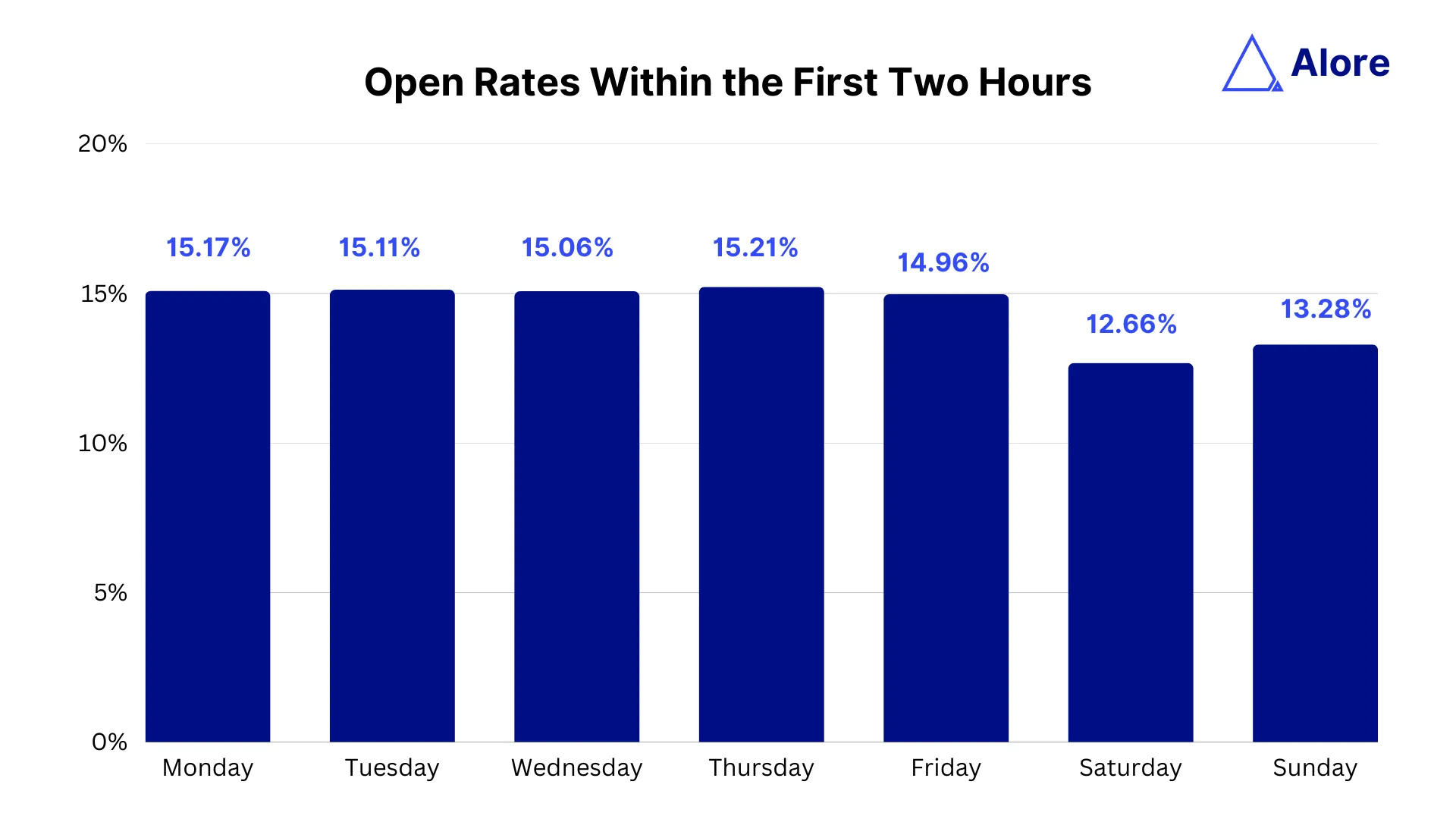
Let's add more meat to the bone with a quick snapshot of the 'Best Days of the Week to Send Email in 2023 Ranked Best to Worst'. Here's how each day of the week stacks up:
- Thriving Thursday: Takes the lead as the prime day to send out your marketing emails. Thursday thrives with an above-average open rate, making it the top contender.
- Terrific Tuesday: Just a step behind, Tuesday shows up as a close second. It's a terrific day to connect with your subscribers.
- Winning Wednesday: Clinching the third spot, Wednesday is a winning choice for launching your email campaigns.
- Mellow Monday: Sliding into fourth place, Monday sees a mellow response, but don't rule it out yet; it's still a weekday!
- Fickle Friday: Falling fifth in line, Friday can be a bit fickle. It might work for some audiences, but for most, the weekend vibes start to seep in.
- Sluggish Saturday: Hitting the second to last spot, Saturday doesn't shine as bright for marketing emails. The open rates generally tend to be sluggish.
- Sleepy Sunday: Lastly, with the lowest engagement rates, Sunday is the day emails tend to sleep in the inbox.
The week laid bare for you!
Remember, these are generalized observations, and the actual results can vary based on your specific audience and their unique behaviors.
So, feel free to test and tweak to identify what works best for your email marketing endeavors!
To Conclude
According to the data, the best days to send marketing emails are typically Tuesday, Wednesday, and Thursday.
Weekends, on the other hand, are generally a no-go zone. But always remember, these are broad strokes painted by analyzing heaps of data. Your audience could still prove an exception to the rule.
So, when you're planning your next email marketing campaign, keep these insights in mind. Experiment, observe, and adjust.
Your data will reveal your unique audience's story, habits, and preferences.
Think of this as your roadmap to finding the sweet spot in email marketing. With this knowledge, you can strategize and conquer the inbox territory. Ready to take on the challenge? Let's harness the power of the best time to send marketing emails and set you up for success!
Breaking Down Best Email Send Times by Hours of The Day

Sending your marketing emails at the right and wrong time, can significantly impact their performance. It's like fishing - you want to cast your line when the fish are most likely to bite. In this section, we'll examine the best and worst times during the day to send marketing emails to optimize your open rates and engagement.
Best Times to Send Emails
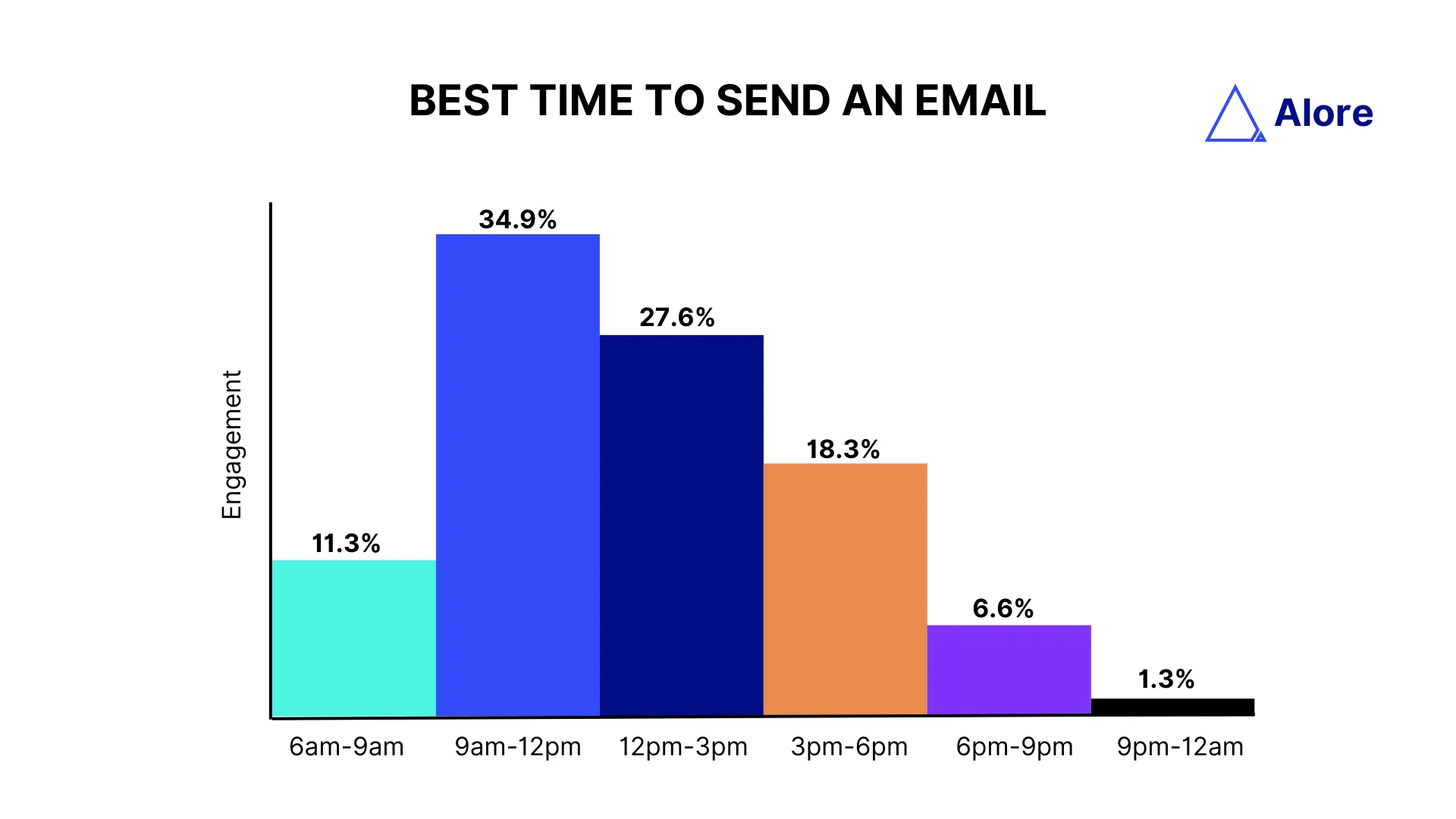
Understanding the most effective times to send emails can help increase your open rates and maximize the impact of your marketing efforts. Here's a breakdown of some of the best times to deliver emails throughout the day:
- Early Morning (6 am – 8 am): Many people habitually check their emails first thing in the morning. Sending emails during these early hours can help you reach your audience while they're fresh and actively engaging with their inbox.
- Mid-Morning Break (10 am – 11 am): By mid-morning, most individuals are well into their workday and may check their emails during a quick break. This presents another window of opportunity for high engagement.
- Post-Lunch Period (1 pm – 2 pm): The period right after lunch can also be a good time to send emails. Your emails can capture your attention once your audience has had their meal and is ready to jump back into work.
- Evening Time (7 pm – 9 pm): As people wind down from their day, they often check personal emails. Sending emails during this time can help you engage with your audience when they're relaxed and have more time to interact with your content.
Remember, these suggested times are not universal truths but general observations that can serve as a starting point. You should adjust these timings based on your particular audience, and their specific habits.
Worst Times to Send Emails
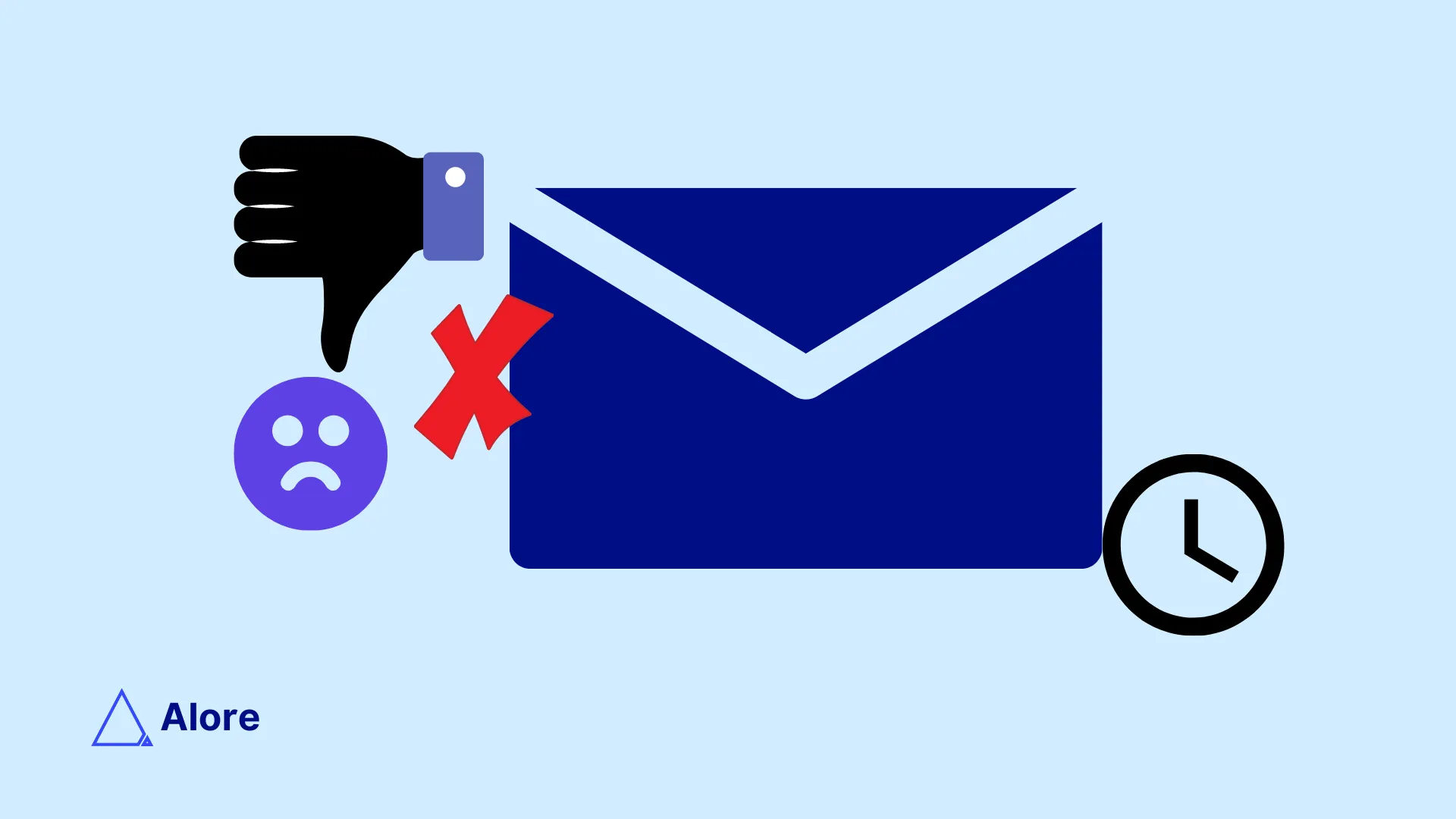
Just as there are prime times to send emails, there are also periods you should avoid sending them to prevent your emails from going unnoticed. These include:
- Late Night (10 pm – 6 am): Most of your audience will likely be asleep during these hours. Emails sent during this time are likely to be lost in the morning influx, decreasing their visibility.
- Lunch Hour (12 pm – 1 pm): Many people take this time to disconnect from their screens and enjoy their lunch. As a result, emails sent during this time often see lower engagement rates.
- Late Afternoon (3 pm – 4 pm): As people wrap up their work for the day or experience the afternoon slump, they are less likely to engage with marketing emails. Avoiding this time slot can help ensure your emails don't get overlooked.
The best time to send marketing emails can vary greatly depending on your audience's specific habits, their time zone, and numerous other factors.
Therefore, monitoring your campaign performance, conducting A/B tests, and tailoring your strategy based on your findings is crucial.
By understanding these patterns and making strategic adjustments, you can optimize your email marketing efforts and ensure your emails land in your target audience's inbox at just the right time. So, are you ready to leverage these insights to enhance your email marketing strategy? Let's get started!
The Best Time to Send Different Types of Emails

Ever wondered if the type of email you're sending could influence the best time to press the "send" button? The answer is a resounding yes! Depending on the kind of email, whether it an editor's note, a newsletter, promotional email, or a transactional email, the ideal send time can vary. In this section, let's dive deep into each category and unravel the mysteries of when to send them for maximum impact.
Newsletters
Sending out newsletters is akin to delivering a digital newspaper to your audience. Just as people prefer reading the morning paper with their coffee, the same goes for newsletters. As per studies, sending newsletters early in the morning, around 6-7 AM, can lead to higher open rates. But remember, consistency is key with newsletters. Try to send them at the same time and on the same day(s) to establish a routine for your readers.
Mass Emails
For mass emails, you're dealing with a wider audience, and hence the timing can get a bit tricky. Considering the work habits of most people, Tuesday and Thursday afternoons, around 2-3 PM, seem to show better engagement. It's when people usually take a small break, and there's a good chance they will check their emails.
B2B Emails
With B2B emails, your target audience is typically other businesses. They are likely to check their emails during regular business hours. Tuesday, Wednesday, and Thursday, especially between 10 AM-12 PM and 2-4 PM, are excellent choices.
B2C Emails
Now, for B2C emails, where you're communicating with consumers, weekends and evenings can perform well. This is about spending time when people have more leisure time to engage with personal emails. Anywhere between 6-9 PM seems to be a good window.
Promotional Emails
Promotional emails work best when sent according to the consumer's convenience. A study shows that 7 PM to 10 PM on weekdays and weekends is a prime time when people have the leisure time to browse and shop.
Transactional Emails
Transactional emails like order confirmations or shipping notifications should be sent immediately following the customer's action. The sooner, the better, as it keeps the customer informed and builds trust.
Welcome Emails
Welcome emails should be sent right after the customer signs up for your service. Immediate delivery ensures high open rates and sets the tone for future communications.
Email Follow-ups
If you're sending a follow-up email, give the recipient a couple of days to respond to your initial email. If you don't hear back, mid-week, or early evening, particularly Wednesday morning, seems to be an optimal time to remind them gently.
Cold Emails
Cold emails can be tricky, as you're reaching out to someone unfamiliar with your brand.
Timing-wise, sending these during regular business hours, particularly Tuesday and Thursday mornings, can get you a higher response rate.
Remember, while these suggestions can serve as a starting point, every audience differs.
It's always a good idea to run A/B tests and review your email analytics to better understand your audience's behavior and preferences. Like many things in marketing, the "best time to send marketing emails" isn't a one-size-fits-all answer. But with careful observation, a dash of trial-and-error, and a sprinkle of patience, you can find the sweet spot for your email marketing strategy.
Personalizing Your Approach: The Importance of Testing and Measuring

Determining the "best time to send marketing emails" isn't an exact science but rather an artful combination of data analysis, testing, measuring, and refining.
It's all about creating a personalized approach that caters to your audience's needs and habits.
In this section, let's explore how to increase your email open rates and engage your audience more effectively.
How to Get Higher Email Open Rates?
Looking to get higher email open rates? Well, you've come to the right place. Improving your open rates starts with understanding your audience's behavior. Are they early birds or night owls? Do they check their emails during lunch breaks or after dinner? Gathering data on your audience's habits can provide valuable insights to optimize your email timings.
Next, consider the quality of your email content. Are your emails providing value to your readers, or are they too salesy?
Remember, content that educates, entertains, or enlightens is more likely to be opened and read.
Finally, don't underestimate the power of an intriguing subject line. A well-crafted subject line can pique your readers' curiosity and compel them to open your email.
Using Advanced Reporting And Analytics Tools
In the digital age, data is your best friend. Advanced reporting and analytics tools can provide you with invaluable insights into your email marketing performance. These tools can track metrics like open, click-through, and bounce rates, providing a clear picture of what's working and what's not.
Based on past performance, such tools can also reveal the best days and times to send your emails. Additionally, they can help you segment your audience based on their behavior, allowing for more personalized and effective campaigns.
Leveraging Email Marketing Automation
Email marketing automation can be a game-changer for your campaigns. It allows you to send out emails at the perfect time, every time, without manually monitoring and clicking the "send" button.
Moreover, it enables you to create triggered email sequences based on specific user actions. For instance, when a customer makes a purchase, an automated email confirmation can be sent immediately, providing a seamless customer experience.
Refining Your Subject Lines
Your subject line is the first thing your audience sees, making it a vital aspect of your email. It acts as the gatekeeper, determining whether your email gets opened or deleted.
To craft compelling subject lines, consider using action words, posing questions, or creating a sense of urgency. Personalization, such as including the recipient's name, can also increase open rates. However, avoid making false promises or using clickbait tactics, as these can damage your reputation and lead to higher unsubscribe rates.
Running A/B Testing Campaigns On Everything
A/B testing is an indispensable tool in your email marketing arsenal. It involves sending two versions of an email to see which one performs better. You can test everything from subject lines, email content, call-to-action (CTA) buttons, to send times.
By continuously testing and measuring your results, you can optimize your emails for better performance. The more data you collect, the more you understand your audience, allowing you to refine your approach and achieve better results.
So, are you ready to roll up your sleeves and dig deep into your email marketing strategy? By leveraging data, utilizing advanced tools, and refining your approach, you can discover the best time to send marketing emails for your unique audience. Remember, it's all about connecting with your audience at the right time, with the right message. Let the testing and measuring journey begin!
Beyond Timing: How to Make Your Emails Stand Out
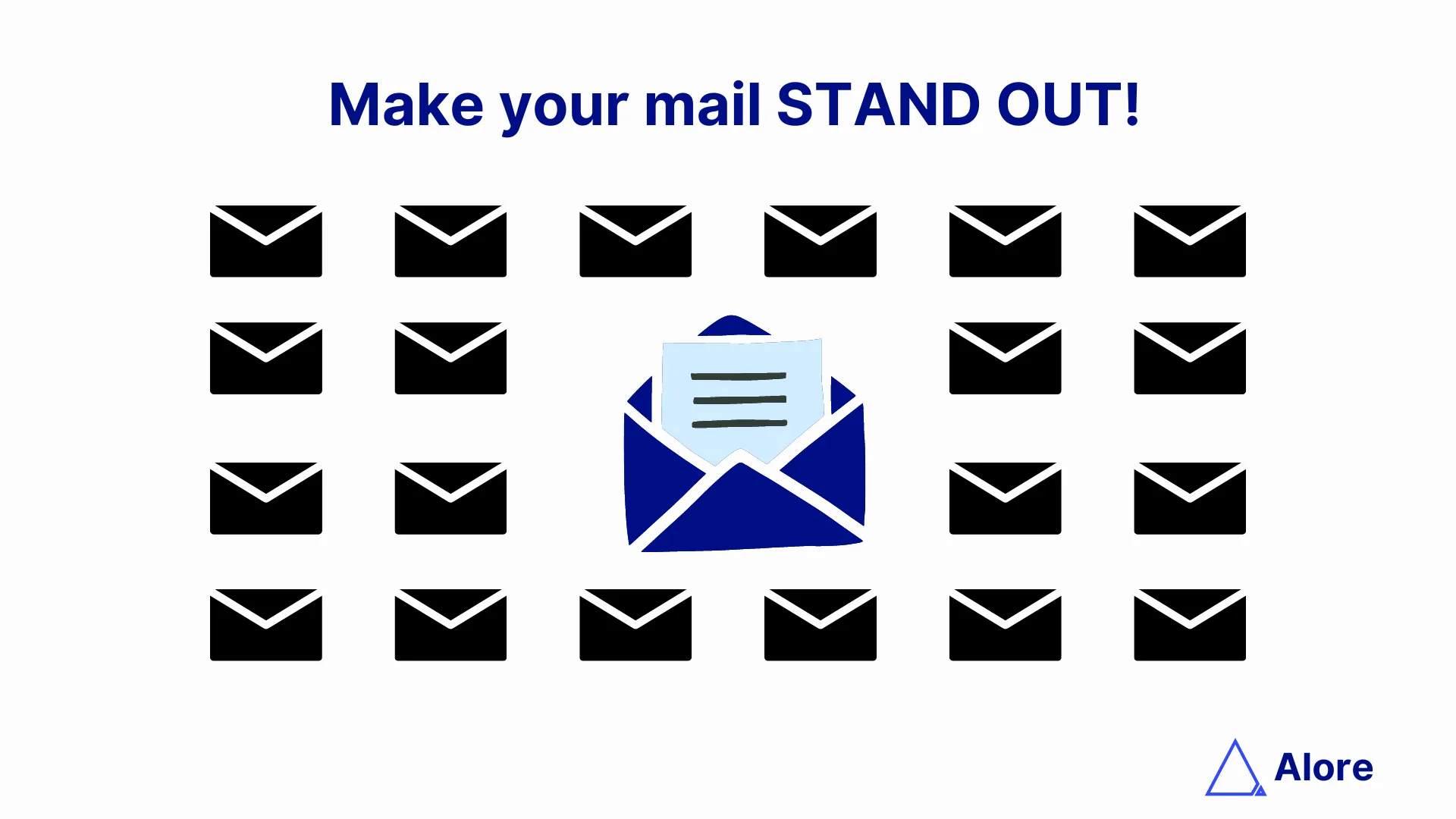
Mastering the "best time to send marketing emails" is crucial, but it isn't the only factor in your email marketing strategy. Even if you've timed it right, there's more to the process. So, let's explore how you can ensure your emails not only get to your subscribers at the right time but also stand out in their crowded inboxes.
Creating Unique and Engaging Content

The best timing won't save an email with dry, boring content. So how do you keep your readers interested?
Start by understanding your audience. What piques their interest? What challenges are they facing? What do they aspire to achieve? Knowing this will guide your content creation strategy.
Next, ensure your content is relevant and relatable. Share real-life examples, case studies, and personal experiences to make your points. Storytelling is a potent tool that can keep your audience engaged and make your content memorable.
Finally, strive for simplicity and brevity. Break down complex ideas into bite-sized information, keeping your content conversational. After all, no one wants to read an email that feels like a long, tedious lecture, right?
Utilizing Compelling Subject Lines
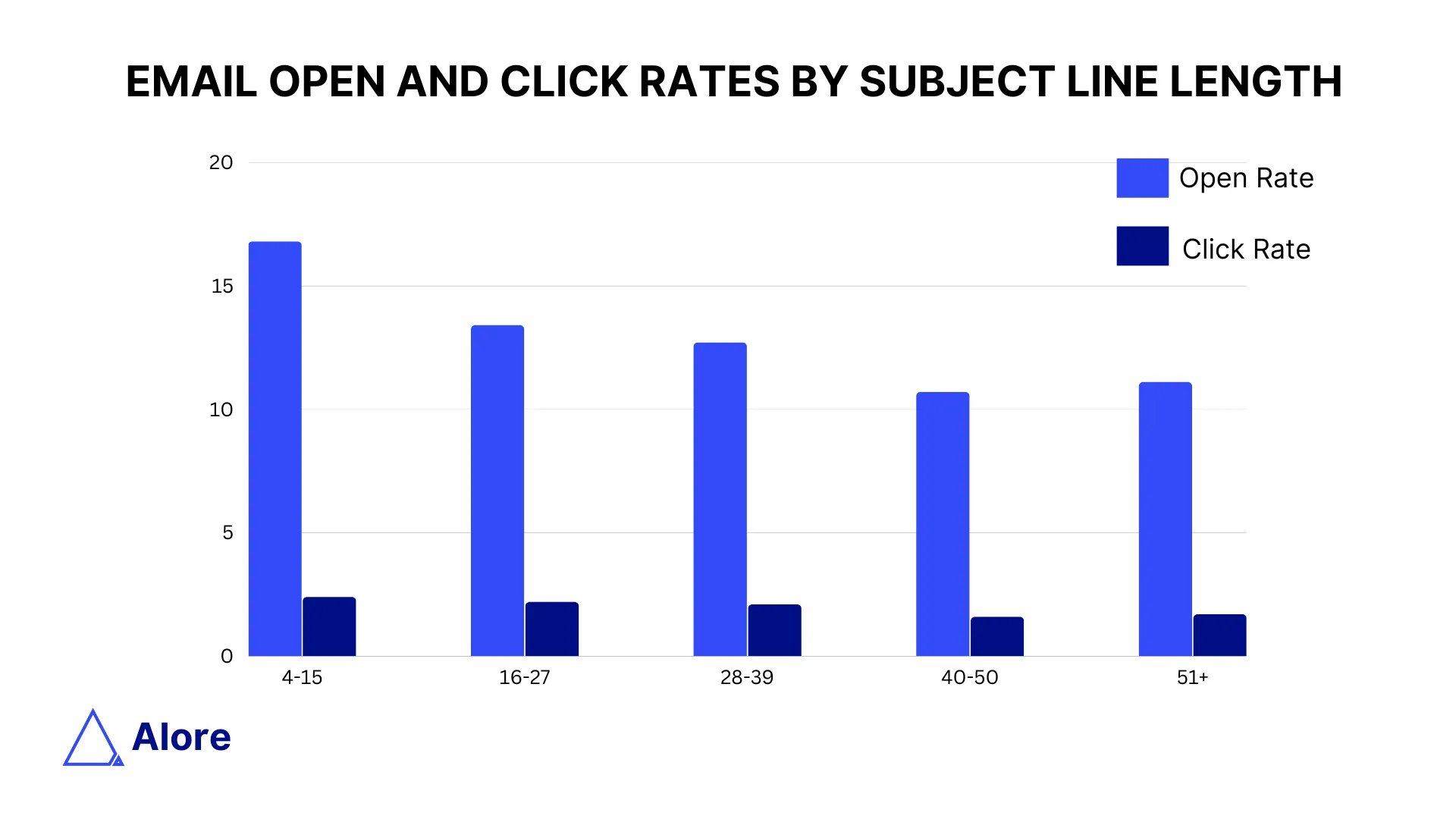
Your email subject line is essentially the first impression your readers get of your email. A catchy subject line can draw readers in, while a boring one can have your email discarded unopened.
A perfect subject line blends creativity, curiosity, and clarity. It should give readers an idea of what the email contains while also arousing their curiosity enough to make them want to open it. Don't shy away from using power words, numbers, or posing questions in your subject lines to make them more enticing. Just remember to deliver on whatever your subject line promises.
Understanding Subscriber Expectations
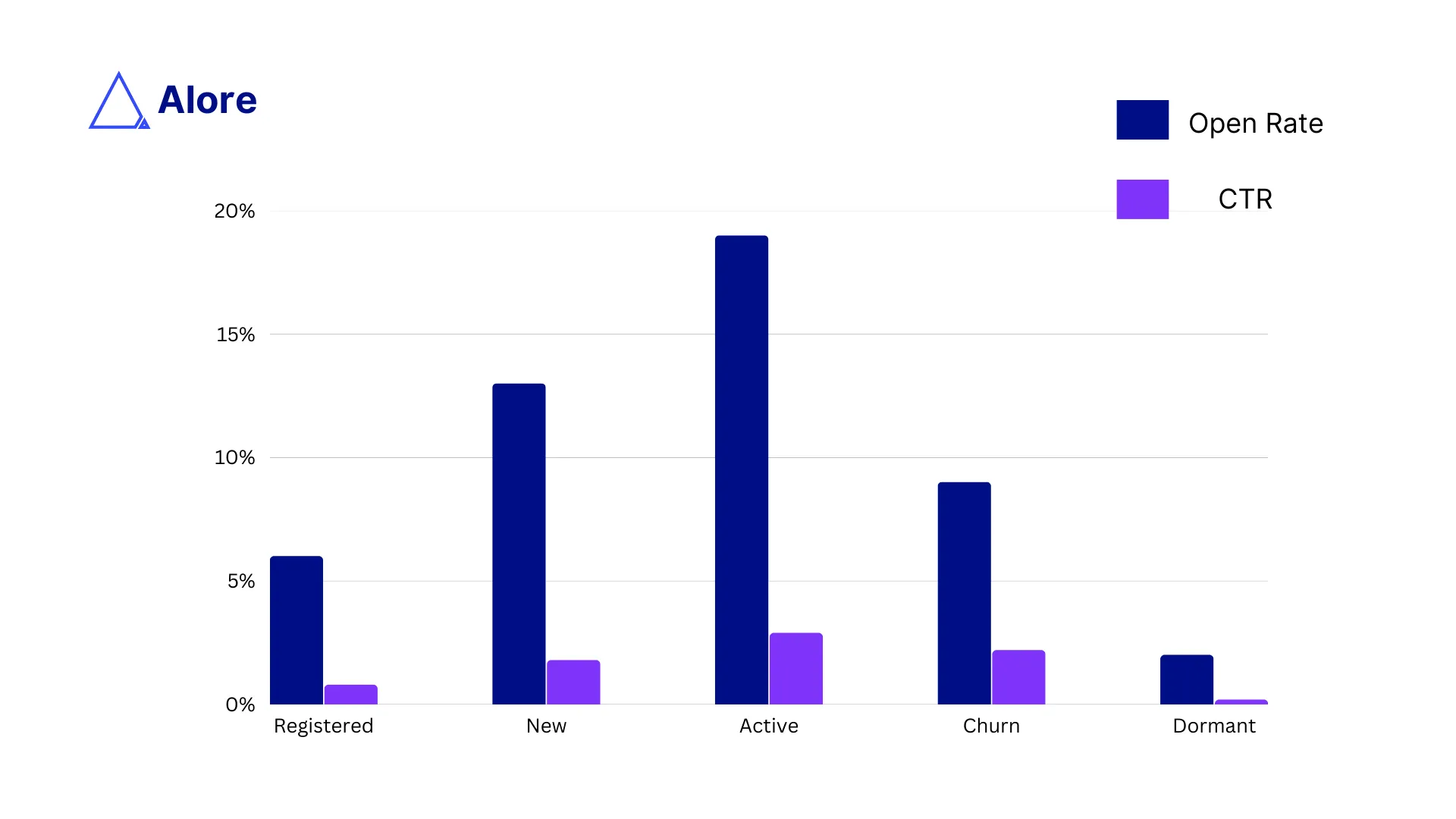
Finally, understanding and managing your subscribers' expectations is vital.
This covers how often they expect emails, the kind of content they anticipate, and yes, even the timing of your emails.
Subscribers sign up to your emails with certain expectations. It could be expecting weekly updates, wanting promotional offers, or seeking informative content.
Consistently meeting these expectations is crucial to keep your subscribers satisfied. If you've promised weekly updates, be sure to deliver on that. Bombarding subscribers with daily emails when they signed up for weekly updates can lead to higher unsubscribe rates.
Similarly, sending your emails at a consistent time can help manage expectations and build anticipation. Think about how frustrating it is when your favorite TV show airs at a different time each week. The same principle applies to your marketing emails.
Frequently Asked Questions About Email Timing
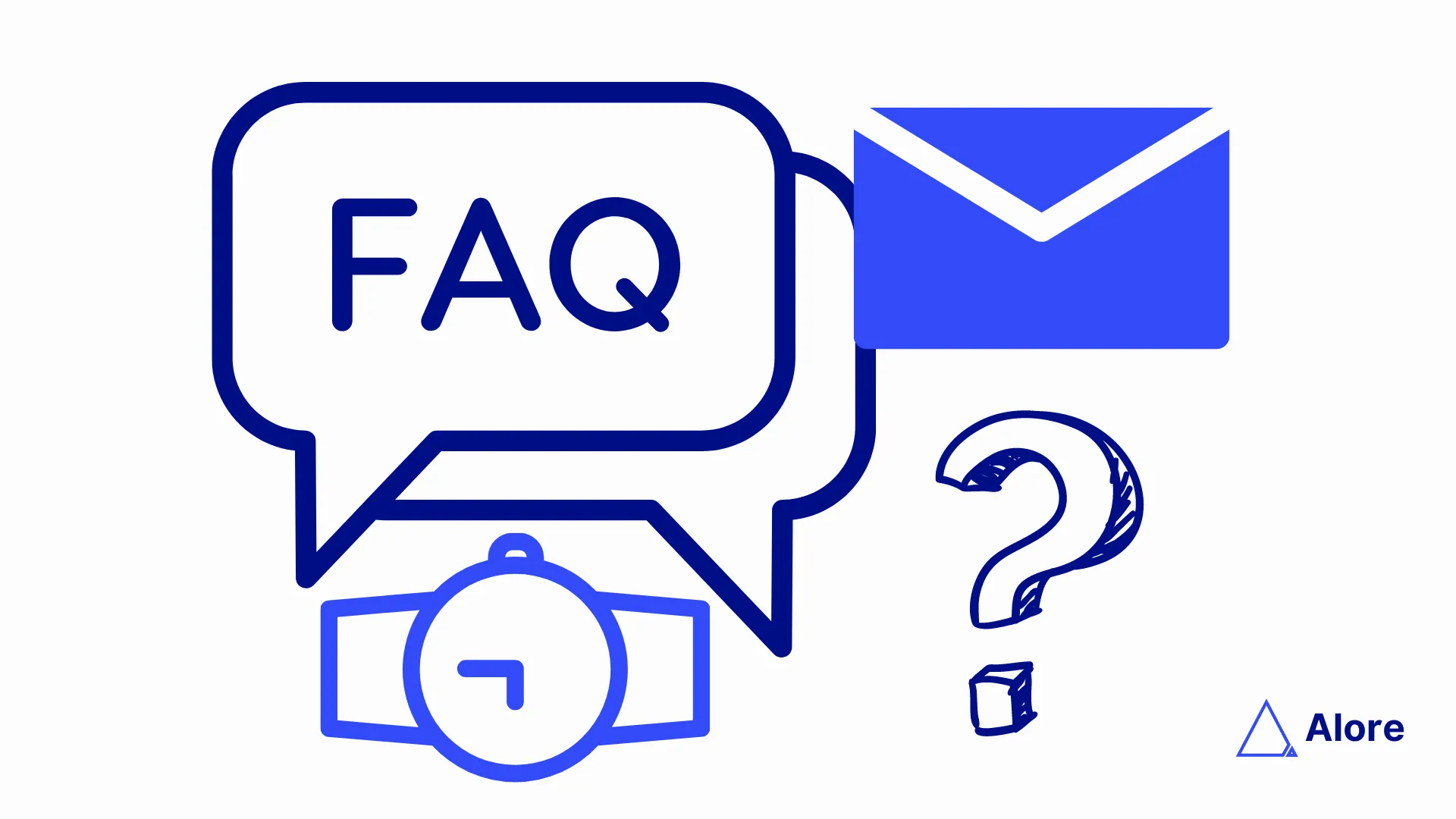
As we've navigated the ins and outs of finding the "best time to send marketing emails," you may have accumulated a few questions. You're not alone! This section addresses some of the most common questions on the topic.
So let's dive in and clear up some of your burning queries.
1. Is there a universal 'best time' to send marketing emails?
You'd be forgiven for thinking that there's a one-size-fits-all solution, but the answer, quite simply, is no. The "best time" can vary greatly based on numerous factors, including your industry, target audience, and the nature of your email content. While studies can offer general guidelines, such as Tuesday at 10 AM, the true "best time" is unique to your audience. This is where A/B testing and data analysis can be invaluable tools.
2. How can I find the 'best time' for my specific audience?
Testing is the best way to find the perfect timing for your audience. You can start by segmenting your audience and sending emails at different times and days. Keep track of open rates, click-through rates, and conversions. With time, patterns will start to emerge. Email marketing tools with built-in analytics can simplify this process.
3. How often should I send marketing emails?
There's a delicate balance to maintain. You want to stay fresh in the minds of your subscribers without overwhelming them. The right frequency varies based on your industry, the type of content you're sharing, and subscriber preferences. A good starting point could be once a week. Monitor your unsubscribe rates closely to understand if you're sending too many or too few emails.
4. Can the 'best time' change over time?
Yes, absolutely. Subscriber behaviors aren't static. Changes in lifestyle, season, or even their relationship with your brand can affect when they're most likely to engage with your emails. So, you should periodically reevaluate your sending times.
5. Should I consider different time zones?
Ideally, yes. If you have a global audience, it's essential to consider various time zones. Sending your emails at 10 AM PST won't be effective for your subscribers in London. Some email marketing platforms can send emails based on the subscriber's local time zone, making this task easier.
6. Is timing the only thing that matters in email marketing?
Timing is just one piece of the email marketing puzzle. While it's important, it's equally crucial to focus on the quality of your content, the attractiveness of your subject lines, and understanding your subscribers' expectations. Remember, an engaging email that arrives at the perfect time is a winning combo!
By now, you should have a clearer understanding of how timing can impact your email marketing strategy. But remember, guidelines and recommendations should serve as starting points. Always fine-tune your strategy based on your audience and their responses. After all, successful email marketing is about connecting with your audience — and what better way to do that than by sending emails when they're most likely to engage?
Conclusion: The Ultimate Answer to the “When to Send an Email” Question

So, we've explored the question that has undoubtedly given many marketers pause: "What is the best time to send marketing emails?" After covering the nuances of this topic, examining various studies and data, and delving into the importance of knowing your audience and testing different timings, are you ready for the ultimate answer? Here it is.
The best time to send a marketing email is... when your audience will most likely engage with it.
Disappointed? Well, don't be. While this answer may seem overly simplistic or perhaps even a bit evasive, it encapsulates the complex and highly personalized nature of email marketing.
Finding the best time to send your marketing emails isn't about looking for a universally applicable 'magic hour.'
It's about understanding your audience - their routines, behavior, timezones - and using this understanding to deliver content when it's most convenient and appealing to them.
That being said, the guidelines discussed throughout this article can provide valuable starting points.
Mid-morning on a weekday, particularly on Tuesdays and Thursdays, seems to be a common sweet spot for many marketers. But remember, these are not rules set in stone. They're averages formed by studying the behavior of diverse groups of people.
Your subscribers are unique. They could be night owls or early birds, or they might check their emails during lunch breaks or in the evening when winding down. This is why analyzing your data and conducting A/B tests is crucial. These practices allow you to observe trends, identify patterns, and refine your email timing based on real, substantial insights from your audience.
But the perfect timing is just one piece of the puzzle. No matter when you send your emails, their content must be worth opening, reading, and engaging with.
It's crucial to create compelling subject lines, personalize content, and ensure the material you share is relevant and valuable to the recipient. After all, the best-timed email in the world won't amount to much if it doesn't resonate with the reader.
As we wrap up our discussion on the best time to send marketing emails, remember that successful email marketing is about more than just timing.
It's about delivering the right message, to the right person, at the right moment. And finding that perfect intersection requires a blend of data analysis, understanding your audience, and continually refining your strategy based on the feedback you receive.
It might seem daunting, but the potential rewards are worth the effort. By effectively engaging your audience through well-timed, high-quality emails, you can build stronger relationships, enhance brand loyalty, and drive significant growth for your business.
In the end, the journey to discovering your 'best time to send marketing emails' is also a journey of learning more about your audience. Embrace this journey. Cherish the insights it provides. And use this knowledge to make every email you send as impactful as possible.
So, are you ready to roll up your sleeves and start exploring when your 'best time' might be?
Because your audience is waiting, and your next successful email campaign could be a well-timed click away.
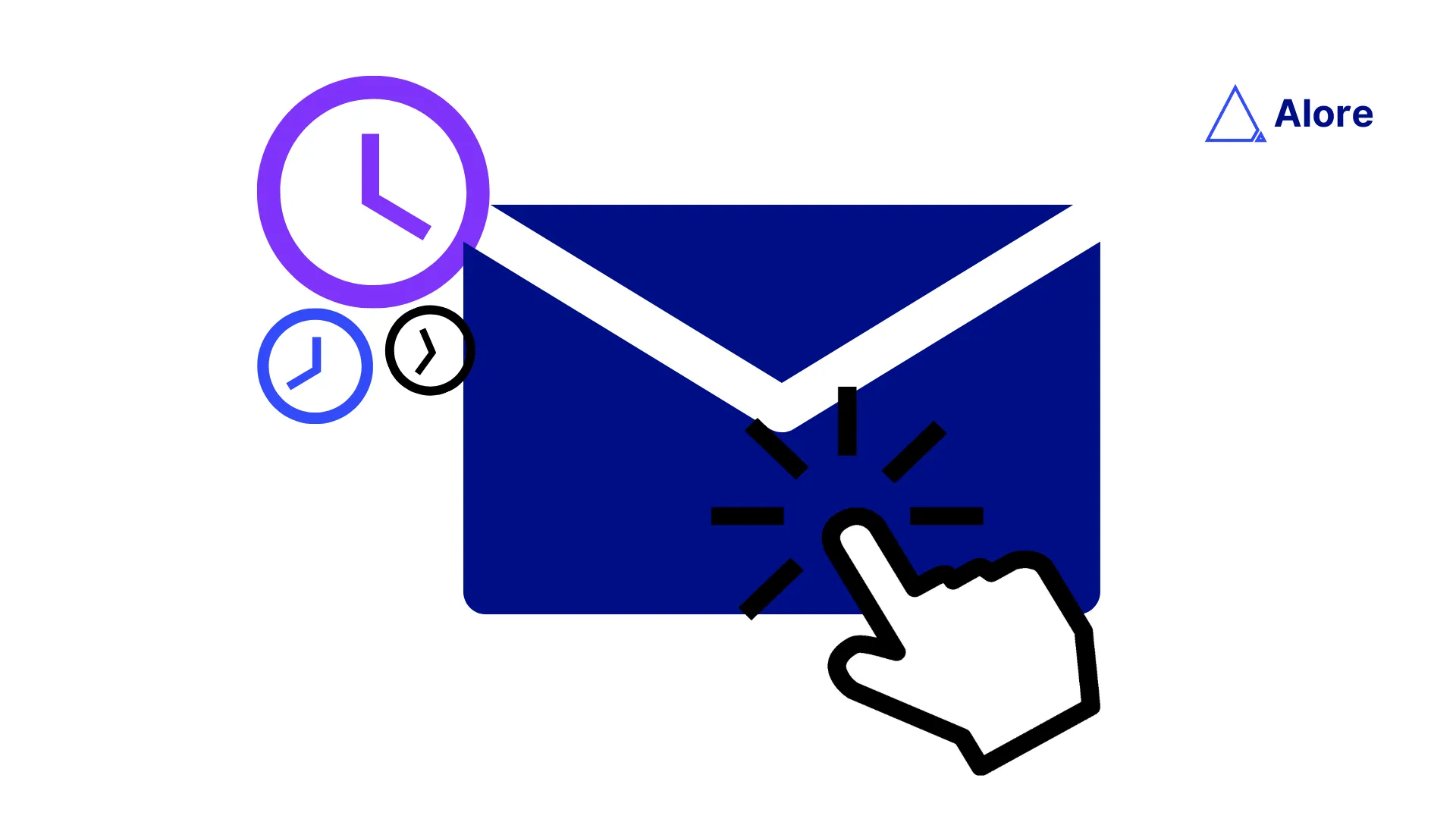





.webp)


